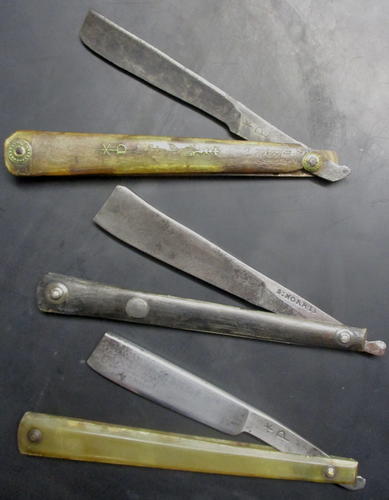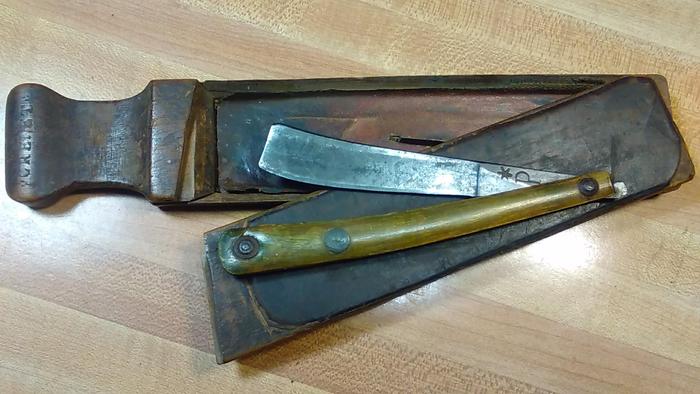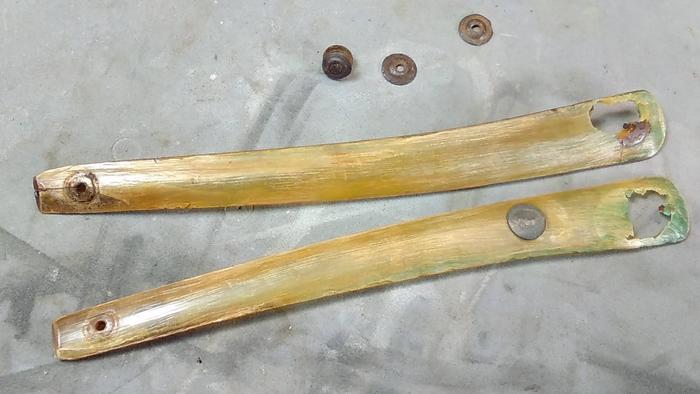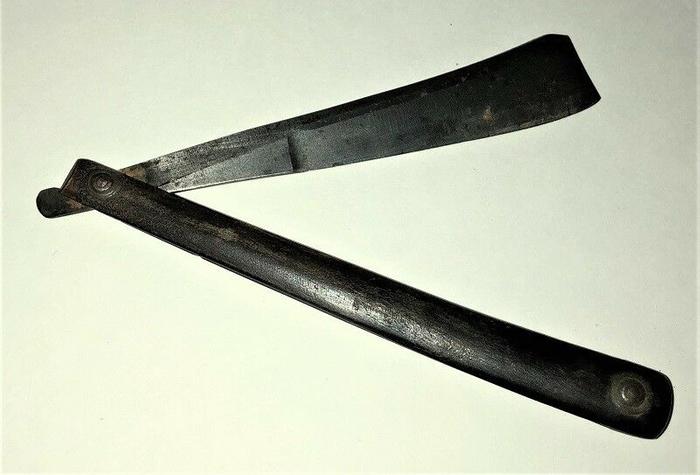Results 1 to 10 of 170
Hybrid View
-
10-28-2018, 10:30 PM #1

Fox & Norris, huh? I don’t think I would have ever figured that on my own. Been going in circles for the last 2 hours and hadn’t gotten anywhere.
Thank you ,SG.
-
10-29-2018, 11:48 AM #2

Actually, a Samuel Norris (1745 - 1817), his parents were Matthew Norris and Catherine Fox.
Catherine Fox was the sister of John Fox, Sheffield, razor-maker (1714 - 1793)
John Fox was one of three brothers, which never married, the mark *P went to Samuel Norris.
Here are 3 razors, the first (with a slight "Dip-at-toe") is a John Fox (see spine). The second
(nice "Dip-at-toe") is a Samuel Norris (not using the *P). The third is a Samuel Norris as well,
using the *P. Since the shape of the razor, it is made around the beginning of the 1800's,
so it must be a Samuel Norris.



Yours is a bit older, it seems to be made around the end of the 18th century - 1800's.
-
The Following 4 Users Say Thank You to Fikira For This Useful Post:
32t (10-29-2018), 782sirbrian (10-31-2018), jfk742 (10-29-2018), MikeT (10-29-2018)
-
10-29-2018, 11:59 AM #3

Your box is marked by the punch of Crenet, Parisian cutler. All the boxes were not marked, but I have already seen. I have a box similar to yours with the punch of Cuvier in Paris.
-
The Following User Says Thank You to lohar For This Useful Post:
jfk742 (10-29-2018)
-
10-29-2018, 12:42 PM #4
-
-
10-29-2018, 01:38 PM #5
-
02-08-2019, 06:20 AM #6Senior Member

- Join Date
- Mar 2018
- Location
- Toronto
- Posts
- 216
Thanked: 15
SO... guess what I finally have in my hands? . Based on the information I read here, and on geneology site(s) across the interwebs and other places, here's a little (possibly slightly fictional) story I made for this razor:
. Based on the information I read here, and on geneology site(s) across the interwebs and other places, here's a little (possibly slightly fictional) story I made for this razor:
Yes, I know - I'm terrible at story tellingStephen Fox, a Cutler in Westbar Sheffield had 3 sons - John, Stephen and William who all went on to follow in their fathers footsteps. He also had daughters amongst whom was Catherine Fox, who (by 1739) had married Matthew Norris, son of another famous cutlers family in sheffield at the time. By 1748 the mark "*P" was registered to "Fox & Norris" - presumably John Fox and Matthew Norris.
John Fox (the oldest) continued to make razors on his own, and under the "Fox & Norris" '*P' brand. By 1777 Son of Catherine and Matthew - Sam Norris was made master cutler, running his own business (eventually "Sam Norris and Sons"). The mark of "*P", however continued to be used by the ever popular "Fox & norris" company until, sometime in the 1790s the last of the brothers - John Fox had died (Matthew Norris and Catherine Fox both having died a few decades prior). Finally dissolving the "Fox and Norris" company and bequeathing the "*P" makers mark to Sam Norris, sometime in the final years of the 18th century. Sam eventually went bankrupt in 1809 and died a few years later.
Sometime between the start of the "*P" mark in 1740s and the death of the last Fox brother in 1790's this razor was made. Likely some years later, when tensions with United States was starting to peak in the early years of 19th century then owner bought a razor strop box for two razors made by parisian cutler "Crenet Fils". Did he buy another razor for it? did he already own one? Or did the razor itself come in a set with two razors made by the now late fox&norris company as the 19th century began...we'll never know. Nor will we ever know what happened to the other razor.
YEARS later, the box along with at least one of the razors found its way to Northern California - perhaps even brought there shortly after the war of 1812 and the tensions between US and UK died down? It eventually found its way to the back of an antique store in a small town somewhere near the bay area...where it was picked up in 2018 - well over 200 years after it was first made. It was then restored by hand, the scales (now bug bitten) re-filled and recolored and shipped to Canada...where it will stay with me for centuries more.
I DID find a twin for this - made by Sam Norris, marked "Sam Norris" so potentially made between 1777 and 1797 (when he would have certainly inherited the "*P" mark and used it?)...so hopefully this razor will not have to miss it's twin for much longer, after almost decades and even a century or two, they will be reunited
 .
.
P.S:
BTW i found some geneology info about Stephen Fox and his family: Stirnet And if you can take a screenshot before the site kicks you out for not logging in - it seems catherine died around 1746? wow that seems REALLY early.Last edited by Tjh; 02-08-2019 at 07:29 PM.
-
-
02-08-2019, 07:57 PM #7

Nice write up, Bro. The story was great.! It could go into greater depth, but was just right.
I'll add a few pics for you.



 Mike
Mike
-
02-09-2019, 07:22 AM #8Senior Member

- Join Date
- Mar 2018
- Location
- Toronto
- Posts
- 216
Thanked: 15
Alright folks, here's another one (is this one "dip at toe" as well?)... initial assessment from Glen says it's in great shape -



As an S:Norris, I'd initially thought this to be 1770-1790 or so, and i'm not sure if this is just the lighting or some regrinding done at some point or what, but there's more of a "shoulder" than I've seen on blades with this shape and from 1700s (not actually a shoulder, but idk what to call it: there's a more pronounced distinction between blade and tang on the plane).
Also: what's the steel marking? I can make out maybe "****AN STEEL" ?
Possible answer from https://acierfondu.wordpress.com/mak.../early-razors/ - "GERMAN STEEL" (razors shown there marked from the 1700's made in sheffield).
More abt "German Steel" here http://www.sheffieldindexers.com/Mem...20Industry.pdf
During the second half of the sixteenth century — the first account of the process
came from Prague in 1574 — someone in Central Europe invented the cementation
process whereby bars of wrought iron were converted to what was commonly known
as ‘blister steel’ because of the various-sized blisters that were raised on the surface.10
It was also known in England as ‘Cullen steel’ because it came via Cologne or as
‘German steel’, but that became a generic name that was applied to cementation steel
made in England during the later seventeenth century. We do not know whether the
‘German steel’ that was sold to Hallamshire scissorsmiths by the Cutlers’ Company in
1681 or the ‘parcel of German Steel’ recorded in the inventory of a Sheffield cutler in
1702 actually came from Germany or from English sources.Last edited by Tjh; 02-09-2019 at 12:23 PM.
-
-
02-09-2019, 09:30 AM #9

Nice German Steel Samuel Norris razor!
No "Dip-at-toe " though, and no shoulder as well, for me it is around 1790
-
02-09-2019, 12:19 PM #10Senior Member

- Join Date
- Mar 2018
- Location
- Toronto
- Posts
- 216
Thanked: 15
oh when i said "shoulder" i meant that...the tang and the blade aren't at equal height there's a little jump there, you can see the shadow...sorry tough to explain. Didn't know what to call it - not that the other blades i've seen don't have it but it seemed more pronounced on this one.
Last edited by Tjh; 02-09-2019 at 12:22 PM.


 317Likes
317Likes LinkBack URL
LinkBack URL About LinkBacks
About LinkBacks






 Reply With Quote
Reply With Quote


